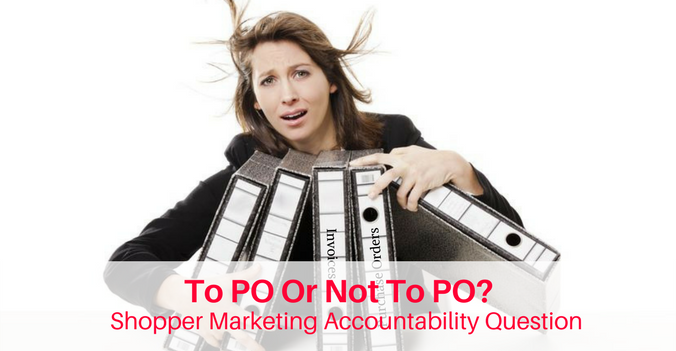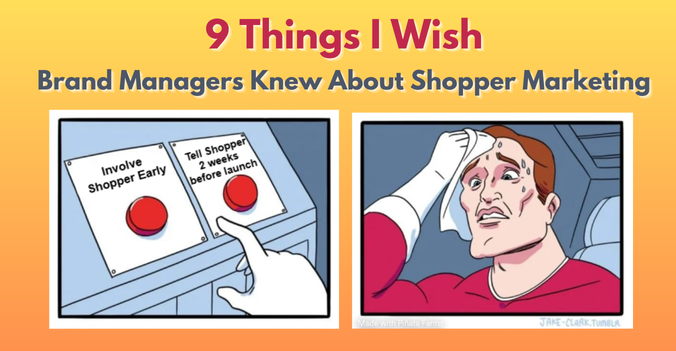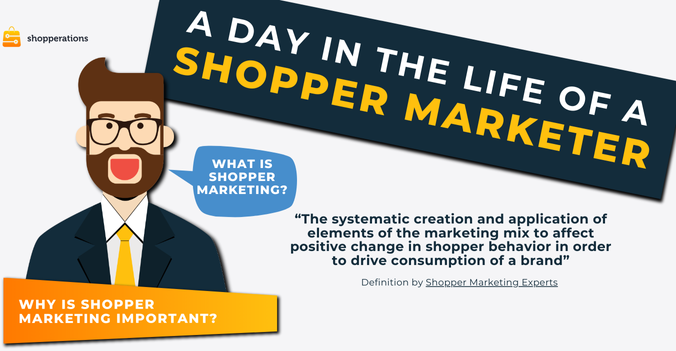
PO stands for Purchase Order, an accounting term for an official document issued by the buyer (your organization) to the seller (your vendor) with specific services, quantities, and agreed upon costs. It is an extra step upfront before vendor invoices are issued, and its purpose is to ensure accountability in managing external suppliers and to avoid overbilling.
While it sounds benign on the surface, there are many downsides to PO for shopper marketing teams.
Here are my main issues with the PO invoice process in shopper marketing:
- The PO process undermines the idea of budget accountability. If budgets are agreed upon in the beginning of the year, why do we demand marketers to go through additional steps to issue documents authorizing the same spend? If you want to instill budget accountability, demand that teams invest to support the strategic priorities and stay within their given budget. A tool like Shopperations can help track budgets and make it easier to stay on track.
- PO documents duplicate SOW work. Before getting paid, any vendor that deals with shopper marketers issues a formal Proposal, Statement Of Work, or Letter of Agreement where services, quantities, and costs are clearly outlined. By asking Shopper Marketers to initiate POs, we are telling them to repeat the same information back to the vendor.
- The PO process imposes a “use it or lose it” mentality, which can result in marketers trying to game the system in order not to lose money. Many marketers may not even be aware of this rule and get “surprised” that their budgets are severely underspent at the end of the year. Those who are aware of this rule often go through a complex PO adjustment process to regain control of underspent funds left in POs.
- The PO process is rigid and results in more back-office, administrative work. Did you know that if an invoice exceeds the PO amount by just a few dollars, an adjustment process has to begin or a new PO has to be issued? This frustrates vendors and creates more work for you to uncover and resolve these issues.
- The PO process is costly. National Association of Purchasing Managers reports that an average PO costs an organization somewhere between $250-$500. Multiply this by the number of programs and vendors your team manages to see how it adds up.
Shopper marketing is especially poorly suited for the PO process
Shopper marketers manage dozens of budgets and hundreds of programs, many of which have multiple tactics and vendors. The shopper marketing scope is not only enormous, the predictability of this spend is very low. Shopper marketers literally re-plan all year long.
PO process may work for large purchases that happen relatively infrequently and are predictable by nature. Large media buys, agency retainer, major investments in systems and tools land themselves well for PO invoice process. Most individual shopper marketing programs, however, are too granular, complex, and volatile to warrant PO invoice processing.
What should we do instead?
Some shopper marketing teams we work with skip the PO step and instead follow the Non-PO process that goes roughly like this:
1. Finance issues cost center IDs that correspond with larger budget buckets (for instance Brand A at Customer Team B). Multiple vendors' invoices from multiple programs can be applied to each cost center.
2. Vendors are instructed to put a budget owner name and the Cost Center ID on each invoice and forward to their marketing contacts for review.
3. Marketers review invoices for any errors, confirm receipt of goods or services, then forward to Accounts Payable to code.
4. The coded invoices come back to shopper marketers' inboxes for electronic approval.
There are multiple Invoice processing solutions on the market, most include Non-PO invoice coding and approval capability. One solution we've seen used successfully in this space is Markview by Kofax (not affiliated with Shopperations).
I hope this post inspired you to evaluate your current business practices, ask deep questions to uncover the intent behind the purchase order process and challenge the status quo. These issues are not trivial, they add up to a significant amount frustration and lost productivity. As a shopper marketing leader, it’s your job to eliminate redundant and time-consuming obstacles to empower your team spend their time on things that truly matter.







